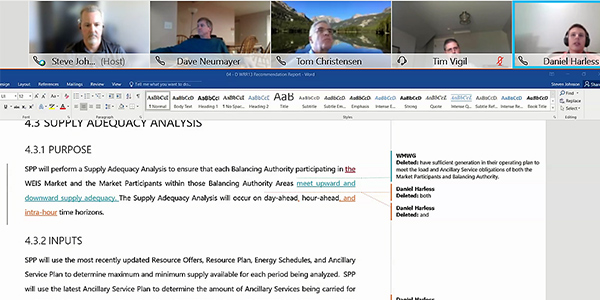SPP’s Western Interconnection stakeholders on Monday voted to move forward with parallel operations, the final test before the Western Energy Imbalance Service (WEIS) market’s planned February launch.
The move will conclude a series of market trials that began in June. WEIS members tested the connectivity between their systems and SPP’s before moving into structured and unstructured testing of dispatch instructions.
The Western Area Power Administration’s Rocky Mountain Region abstained from the vote, saying it had to “work things out contractually.”
“We’ve got to finish strong,” SPP’s David Kelley, director of seams and Tariff services, told the Western Market Executive Committee (WMEC) during its meeting Monday. “We’ve been strong to this point. There’s a lot of work to do. I’m confident we’ll meet that challenge.”
SPP has yet to receive SPP Responding to WEIS Tariff Protests.)
On Wednesday, SPP held a meeting for new members on the RTO’s integration process. Staff discussed the confidentiality agreements necessary to participate in some future meetings and fielded comments by some of the Western utilities evaluating WEIS membership.
WMEC Approves 6 WRRs
The WMEC remanded back to the Western Markets Working Group a WEIS revision request (WRR) providing further guidance on service flow constraints (SFCs) following concerns raised by SPP’s Market Monitoring Unit.
The proposed change (WRR16) would add a list of SFCs as an appendix to a business practice (BP). The MMU pointed out that “on-the-fly” SFCs cannot be represented in real time in an appendix.
“We have concerns about duplicative or misleading information,” the MMU’s Ian Wren said. “Why have an appendix at the outset when we know it will never be accurate?”
Kelley said including the list in an appendix was an effort to provide transparency and meet the Tariff’s requirements. “We just committed in the Tariff to make it publicly available,” he said.
The MMU and staff agreed the concerns could be addressed by posting the SFC list online.
The WMEC asked the working group to eliminate WRR16’s reference to the appendix. Staff will research all WEIS governing documents, including outstanding revision requests, to remove any other references to the appendix.
The committee approved six other WRRs. The measures cleared unanimously with the exception of WRR13 and WRR14; the Municipal Energy Agency of Nebraska abstained from both votes.
- WRR10: ensures the WEIS market’s dispatch of resources does not violate an operating instruction when resources are deployed for ancillary services (AS) by limiting the instruction’s upper limit, reduced by the resource’s upward AS.
- WRR11: cleans up language from previous market designs or carried over from the Integrated Marketplace’s protocols and accidentally left in.
- WRR12: adds language describing marginal losses and the loss-adjustment factor to align with WRR8.
- WRR13: removes the supply adequacy analysis’s undersupply description and documents the real-time operating constraint to be activated when a participating balancing authority has not resolved an energy obligation deficiency, aligning the WEIS protocols with WRR7.
- WRR14: recognizes the market economic dispatch’s physical and non-physical constraints and defines the term “market operator.”
- WRR15: adds WEIS BPs to the WRR process, allowing stakeholders to create, modify and delete BPs.







